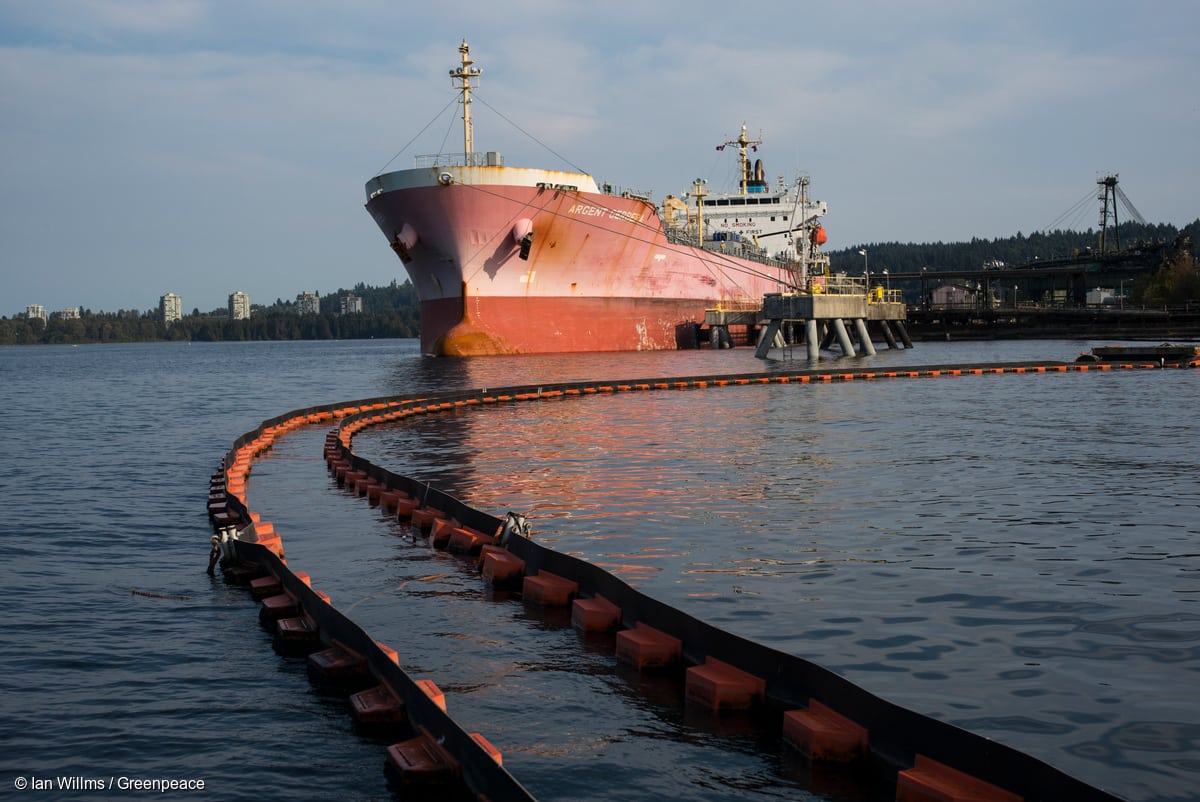Read the report here.
The movement against tar sands oil pipelines has been gaining overwhelming momentum all around the world. From long-standing Indigenous-led activism in Canada and the Coast Salish territory to widespread protests in Europe and the U.S., thousands of people have formed a united movement to stop oil companies from putting water at risk, fueling climate change, and violating Indigenous rights with their destructive pipelines. While numerous pipelines are being proposed all across North America, the Pacific Coast is now facing a critical threat that could have widespread impacts on marine life, local economies and the communities in its path — the Trans Mountain Expansion Project.
The existing Trans Mountain pipeline currently transports around 300,000 barrels of oil per day from Alberta, Canada, to the Pacific Coast. A majority of this oil arrives at refineries in Washington State via the Puget Sound Pipeline, yet a portion reaches the Westridge Marine Terminal (WMT) in Burnaby, British Columbia, where it is loaded onto oil tankers and barges for transport to refineries and other locations along the Pacific Coast, and across the Pacific to Asia.


Comparison of the tracks of all 2013 departures from WMT (top) against simulated tracks reflecting a seven-fold increase in tankers departing WMT (bottom).
The current expansion of this pipeline has provoked an Indigenous-led resistance movement. First Nations who live along the route, supported by thousands of people on both sides of the colonial border, have emphasized their lack of consent for the project, inadequate consultation by the Canadian government, and violations of Indigenous sovereignty. In response to mass protest and sustained action against Kinder Morgan and the pipeline expansion, the Texas-based company announced it would sell the existing pipeline to the Canadian government for 4.5 billion (CAD), and would finish building the TMEP. This deal allows Kinder Morgan to wash their hands of the conflict, potentially leaving Canadian taxpayers on the hook for a troubled and controversial project.
Canada is a country of the rule of law, and the federal government will act in the national interest. Access to world markets for Canadian resources is a core national interest. The Trans Mountain expansion will be built. https://t.co/97vvScpvOo
— Justin Trudeau (@JustinTrudeau) April 9, 2018
And if the government of Canada gets its way, this pipeline could almost triple in its capacity to move tar sands from Alberta to the coast. The proposed expansion would greatly expand the capacity of this system, increasing the number of tankers leaving the Westridge Marine Terminal by a factor of almost seven — from 5 tankers per month to as many as 34, or more than 400 a year. Much of the oil transported by TMEP is expected to be diluted bitumen — also known as dilbit — extracted from Alberta’s tar sands. While any oil spill is harmful and extremely difficult to clean up, the dilbit can sink when spilled into water, potentially making clean up vastly more difficult than a conventional oil spill.
The aim of this report is to illustrate the immense risk that communities and wildlife along the Pacific Coast would face if the proposed Trans Mountain Expansion Project is completed. First Nations, Indigenous, and other communities along the pipeline and tanker superhighway routes will bear the risks of this project. What is so clear from this report is that the Trans Mountain Expansion Project must be halted for the sake of the health and safety of our communities, local economies, marine life, and our climate.
Here is a summary of our findings, and you can access the full report here.
Summary Results
- The proposed Trans Mountain Expansion Project would increase the number of oil tankers carrying tar sands from Vancouver, Canada through the Salish Sea and down the Pacific Coast of the U.S.
- This report presents a map and analysis of 176 oil tanker and barge departures from the Westridge Marine Terminal in British Columbia from 2013 to the beginning of 2018.
- Over half (94) of those departures then sailed the length of the Pacific Coast to the port of Long Beach, California, with significant numbers heading to destinations in Washington State (36), the San Francisco Bay Area (23), and various locations in Asia and Hawaii (17).
- These results indicate that while the physical pipeline may stop at the water’s edge, a diluted bitumen spill remains a risk for coastal communities all along the Pacific Coast — from British Columbia to Washington to Oregon to California.
- Studies have estimated a 10%-29% chance of a “worst case” tanker spill (>100,000 barrels) over the next 50 years.
- The endangered Southern Resident orca population could be driven toward extinction by the increased ship noise, and risk of oil spills and ship strikes, resulting from TMEP.
- Coastal communities that rely on fishing and tourism have suffered billions of dollars in economic damages following previous catastrophic marine oil spills.
- The $60 billion coastal economy of Washington, Oregon, and California currently supports over 150,000 jobs in commercial fishing and over 525,000 jobs in coastal tourism.
- In the British Columbia Lower Mainland, industries that rely on a clean coastline employ more than 320,000 people.
- Studies have found that a major oil spill in Washington would cost $10.8 billion, and one in Vancouver would cost $1.2 billion (CAD).



